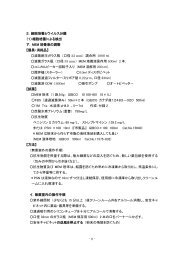Program and Abstracts(PDF)
Program and Abstracts(PDF)
Program and Abstracts(PDF)
Create successful ePaper yourself
Turn your PDF publications into a flip-book with our unique Google optimized e-Paper software.
Presentation 23<br />
POND-TO-PLATE ANALYSIS OF THE US FARM-RAISED CATFISH INDUSTRY<br />
Terrill R. Hanson<br />
Department of Fisheries <strong>and</strong> Allied Aquacultures, Auburn University, Auburn, Alabama 36849,<br />
USA<br />
Email: hansontr at auburn.edu<br />
US produced catfish <strong>and</strong> sales in the US have been declining from 662 million pound of<br />
processed catfish in 2003 to 466 million pounds in 2009, while during the same period imports of<br />
tilapia, basa, tra <strong>and</strong> channel catfish were increasing. Several reasons have an impact on this<br />
situation, including lower import fish prices, increasing domestic feed/fuel prices, inefficiencies<br />
in US catfish production, <strong>and</strong> quality inconsistencies in domestically produced products. It has<br />
been recognized by many US catfish industry representatives that reactive policies <strong>and</strong> actions of<br />
the past have failed to revive the industry <strong>and</strong> a pro-active focus on industry improvement at all<br />
levels is needed. Thus, the Pond-to-Plate project was initiated, with the goals of improving the<br />
competitiveness of the US farm-raised catfish industry <strong>and</strong> evolving it into a modern livestock<br />
industry. Auburn University’s Fisheries Department has brought in LEAN trainers from the AU<br />
College of Business to assist in conducting Pond-to-Plate meetings in West Alabama.<br />
This project uses the LEAN manufacturing <strong>and</strong> continuous improvement concept, <strong>and</strong> has<br />
been introduced at Pond-to-Plate meetings held in West Alabama. Each meeting includes<br />
participant representatives of the value chain, i.e., catfish producers, harvesters, transporters,<br />
processors, distributor <strong>and</strong> consumers. The LEAN enterprise produces more with existing<br />
resources by eliminating non-value-added activities. Manufacturers are facing increased<br />
worldwide competition <strong>and</strong> the stakes are high. The winners in this competition work to<br />
eliminate overproduction caused by traditional scheduling systems <strong>and</strong> to only make what<br />
customers want when they want it. Lean establishes a systematic approach to eliminate these<br />
wastes <strong>and</strong> create a flow throughout the whole company. It also helps companies develop <strong>and</strong><br />
implement a long-term plan to streamline their operations for success. Training uses a h<strong>and</strong>s-on<br />
approach involving a mixture of company’s management <strong>and</strong> staff members. This approach was<br />
modified to address the fact that the US catfish industry is not one company but comprised of<br />
independent US catfish producers with few formal ties to processing plants.<br />
Catfish Pond-to-Plate meetings have used Lean principals to address key issues of industry<br />
efficiency at each level of the value chain, increasing dem<strong>and</strong> for catfish products, lack of<br />
product/value informational flow, final customer/consumer needs/desires, <strong>and</strong> non- or misaligned<br />
objectives, product quality needs, <strong>and</strong> incentives/rewards among value chain members to<br />
produce consistently high quality products. Meetings have resulted in articulated vision<br />
statements addressing the key issues identified <strong>and</strong> have focused on activities to reach their stated<br />
goals of increasing per capita consumption of US farm-raised catfish.<br />
46



